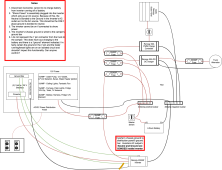CampingLife
New Member
Hi All,
I am looking at adding a 2000W Renogy inverter to my truck camper. My current plan is to add this as an AC source, so it'll go straight to the distribution panel in the camper as if it was shore power or a generator, from there it'll run the ac circuit in the camper as it pulls from the 12v lithium battery. I also have solar and a dc-dc charger connected to my truck. I'm assuming the 7-pin truck connector's gorund cable is for the running/break lights on the camper and those are on a different circuit. I'm not sure how the aux-charging in the 7-pin connector impacts my system.
My primary concern is getting the "ground" correct for the system with an inverter added. My understanding is that the panel in the camper is considered a "sub-panel" and neutral and ground are not bonded. When you plug your camper into a generator, that generator bonds neutral with ground so if there is a fault, breakers or fuses blow so you don't get a zap when you touch a charged item. Alternatively, if you plug into shore power, you utilize shore power's ground. Now, with the inverter acting as my "shore power", I think the neutral needs to be bonded with the ground. Reading through the renogy manual, it explicitly states that the wired AC output has neutral bonded to ground within the inverter, so I should be good to essentially wire my inverter into the camper's distribution panel. Additionally, I"ll need to route the Inverter's chassis ground to the distribution panel's ground bus bar in case there is a fault and the inverter case becomes charged. Additionally, I"ll need to ensure that the converter is disable when the inverter is on and I'm guessing the inverter needs to be off if shore power is actually plugged in...but I"m not sure on this. Really appreciate any feedback. I have diagramed out the major components below:

Thank you!
I am looking at adding a 2000W Renogy inverter to my truck camper. My current plan is to add this as an AC source, so it'll go straight to the distribution panel in the camper as if it was shore power or a generator, from there it'll run the ac circuit in the camper as it pulls from the 12v lithium battery. I also have solar and a dc-dc charger connected to my truck. I'm assuming the 7-pin truck connector's gorund cable is for the running/break lights on the camper and those are on a different circuit. I'm not sure how the aux-charging in the 7-pin connector impacts my system.
My primary concern is getting the "ground" correct for the system with an inverter added. My understanding is that the panel in the camper is considered a "sub-panel" and neutral and ground are not bonded. When you plug your camper into a generator, that generator bonds neutral with ground so if there is a fault, breakers or fuses blow so you don't get a zap when you touch a charged item. Alternatively, if you plug into shore power, you utilize shore power's ground. Now, with the inverter acting as my "shore power", I think the neutral needs to be bonded with the ground. Reading through the renogy manual, it explicitly states that the wired AC output has neutral bonded to ground within the inverter, so I should be good to essentially wire my inverter into the camper's distribution panel. Additionally, I"ll need to route the Inverter's chassis ground to the distribution panel's ground bus bar in case there is a fault and the inverter case becomes charged. Additionally, I"ll need to ensure that the converter is disable when the inverter is on and I'm guessing the inverter needs to be off if shore power is actually plugged in...but I"m not sure on this. Really appreciate any feedback. I have diagramed out the major components below:

Thank you!
Last edited:


